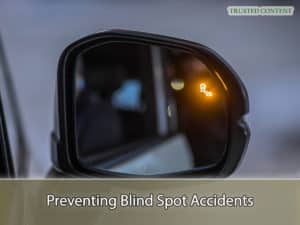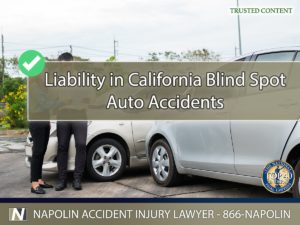Liability in California Blind Spot Auto Accidents
Blind spot accidents remain a significant hazard on California roads, often leading to complex legal battles over liability and compensation. These accidents occur when drivers fail to detect other vehicles or pedestrians in the obscured areas not visible through their mirrors, typically at the sides or rear of their vehicle. Understanding California’s legal approach to these incidents is crucial for any driver, as the consequences of such accidents can be severe, involving serious injuries or even fatalities. This guide aims to unpack the intricacies of liability in blind spot accidents and provides essential knowledge on how these cases are typically resolved in California.

Understanding Blind Spots and Accident Risks
Understanding Blind Spots and Accident Risks
Definition and Impact of Blind Spots
Blind spots are defined as the areas outside a driver’s immediate line of sight that are not visible through standard use of mirrors. Every vehicle has blind spots, and their size and location can vary significantly depending on the vehicle’s design. For larger vehicles, such as trucks and buses, these blind spots are more substantial, increasing the risk of overlooking smaller vehicles or pedestrians. Recognizing where these blind spots exist and how they impact visibility is essential for all drivers to prevent accidents.
Common Scenarios Leading to Accidents
Blind spot accidents most commonly occur during lane changes, merging onto highways, or when navigating complex urban intersections. Such incidents are also frequent in parking lots when drivers back out from parking spaces without a clear view of the surroundings. Additionally, high-speed roads pose a significant risk as drivers may not detect a vehicle entering their blind spot while focusing on the road ahead. Understanding these common scenarios can help drivers anticipate and mitigate risks associated with blind spots.
Legal Aspects of Blind Spot Accidents
Establishing Fault in Blind Spot Accidents
Fault determination in blind spot accidents in California hinges on establishing negligence. A driver who fails to ensure the absence of other vehicles in their blind spot before making a lane change or merging might be considered negligent. However, establishing liability can be complex, especially when multiple vehicles are involved. Legal outcomes depend on detailed evidence showing whether each driver acted responsibly and complied with traffic regulations at the time of the accident.
Importance of Evidence
The role of evidence in blind spot accident claims cannot be overstated. Immediately after an accident, it is crucial to collect as much information as possible. This includes photographs of the accident scene, video footage from dash cams, eyewitness accounts, and official police reports. Such evidence can provide definitive proof of circumstances leading up to the accident and help legal professionals reconstruct the event accurately.

Preventing Blind Spot Accidents
Preventing Blind Spot Accidents
Drivers can take several proactive measures to prevent accidents caused by blind spots. Regularly adjusting mirrors to maximize the field of vision and using appropriate technologies such as blind spot detection systems can significantly reduce risks. It is also crucial for drivers to develop the habit of physically checking over their shoulder before changing lanes or merging, as this action can reveal vehicles or obstacles that mirrors might miss. Educational programs emphasizing these practices could enhance overall traffic safety.
When Accidents Happen: Legal Steps to Take
In the event of a blind spot accident, specific steps should be taken to protect one’s legal rights. First, ensure that all parties involved are safe and contact emergency services if there are any injuries. Document the scene with photos and gather contact information from all parties and witnesses. Then, notify your insurance company about the incident. Most importantly, consult with a qualified personal injury attorney who specializes in auto accidents to discuss your case details and understand your legal options.
Navigating California’s Comparative Negligence Law
California’s comparative negligence law allows for compensation even if the victim is partially at fault. Under this rule, each party’s fault percentage is calculated, and damage awards are adjusted accordingly. This means that even if you were partially responsible for an accident, you might still receive compensation, albeit reduced by your share of the fault. Understanding this law is crucial for anyone involved in a blind spot accident as it directly influences the potential outcomes of legal claims.

Liability in California Blind Spot Auto Accidents
Liability in California Blind Spot Auto Accidents
Blind spot accidents require careful legal consideration given their potential for significant physical and financial impact. For drivers in California, understanding the nuances of such incidents and the associated legal processes is imperative. If you find yourself involved in a blind spot accident, or if you need guidance on how to handle the aftermath, contact Napolin Accident Injury Lawyer at (866)-NAPOLIN. With extensive experience in handling similar cases, we are well-prepared to provide the support and representation you need to navigate these complex legal waters and ensure your rights are protected.
- A Guide on Red Light Auto Accidents in California - August 14, 2024
- Self-Representing in a California Personal Injury Claim - August 13, 2024
- Common Sources of Distraction for Drivers in California - August 13, 2024
